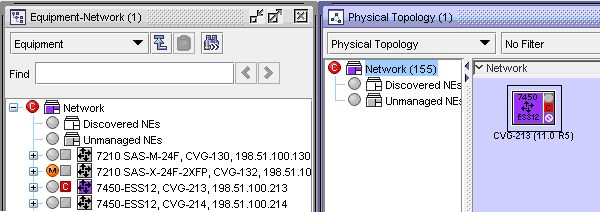Device management states
Description
A device can be in one of the following management states:
-
unmanaged—an operator has unmanaged the formerly managed device; the management information is removed from the NFM-P database. See see Unmanaging and deleting devices for more information
-
suspended—an operator has suspended management of the device; see Suspending device management for more information
NEs not associated with a discovery rule
After a discovery rule is deleted, any managed devices associated with the discovery rule are not subsequently included in certain network administration tasks such as NE version change detection.
In the event that a discovery rule is deleted, perform To associate a device with a discovery rule to ensure that the managed devices associated with the discovery rule are included in subsequent network administration activities,
Unmanaging and deleting devices
|
CAUTION Service Disruption |
Unmanaging or deleting a device results in the loss of all historical AA statistics for the device.
Using the NFM-P to unmanage a device excludes the device from the managed network, but a reference to the device remains in the NFM-P discovery system. The unmanage function may be used for unusual conditions such as when the NFM-P requires a complete refresh of device data because of data corruption. Unmanaging a device results in a loss of management data for the selected device, which includes, but is not limited to, the following:
Deleting a device results in the complete loss of management data for the device and completely removes the device from the managed network.
Suspending device management
|
CAUTION Service Disruption |
When you suspend the management of a device, the NFM-P raises a critical alarm against the device.
When you need to exclude a device from NFM-P management but do not want to lose the NFM-P information about the device, for example, during a maintenance period that may generate an exceptional number of SNMP traps, you can use a GUI or OSS client to suspend the management of the device.
When you suspend management of a device, the NFM-P removes the associated trap targets from the device configuration, and blocks the following operations:
-
SNMP deployment and trap handling; all traps from the device are dropped
-
GUI or OSS client configuration of device parameters; a configuration attempt results in a failed deployment
-
scheduled or periodic operations that the NFM-P initiates, for example:
Note: You cannot suspend the management of a device while a software upgrade or configuration backup is in progress on the device.
By default, the NFM-P does not raise alarms against suspended NEs. You can override the default setting using a parameter in the main-server configuration file. Contact technical support for more information.
You can use the NFM-P to perform the following on a suspended device:
-
configure NFM-P parameters that affect the device management but are not deployed, such as the in-band or out-of-band management preferences
Note: By default, the NFM-P suppresses alarms for suspended NEs. If you attempt to modify an OAM test or test suite that is deployed to a suspended NE, the NFM-P raises an alarm. The alarm does not automatically clear when the NE is remanaged.
As shown in Figure 9-1, GUI representation of suspended device , when a device is suspended, the device icons in the network navigation tree and physical topology map are colored purple. When a suspended device is in a group other than the Network group, only the lower right corner of the Network group icon is colored purple.The following icons are also colored purple to indicate that at least one device is suspended:
Note: The group icon colors are prioritized; when a group contains one or more unreachable NEs and one or more suspended NEs, the group icon is colored red.
Figure 9-1: GUI representation of suspended device

When you return a suspended device to the managed state, the NFM-P rediscovers the device to capture events such as device reboots or software release changes, and initiates a full device resynchronization based on the response to a trap sequence ID check.
Note: The NFM-P also checks the device management parameters to adapt to a switch from one type of management to another, for example, from in-band to out-of-band.